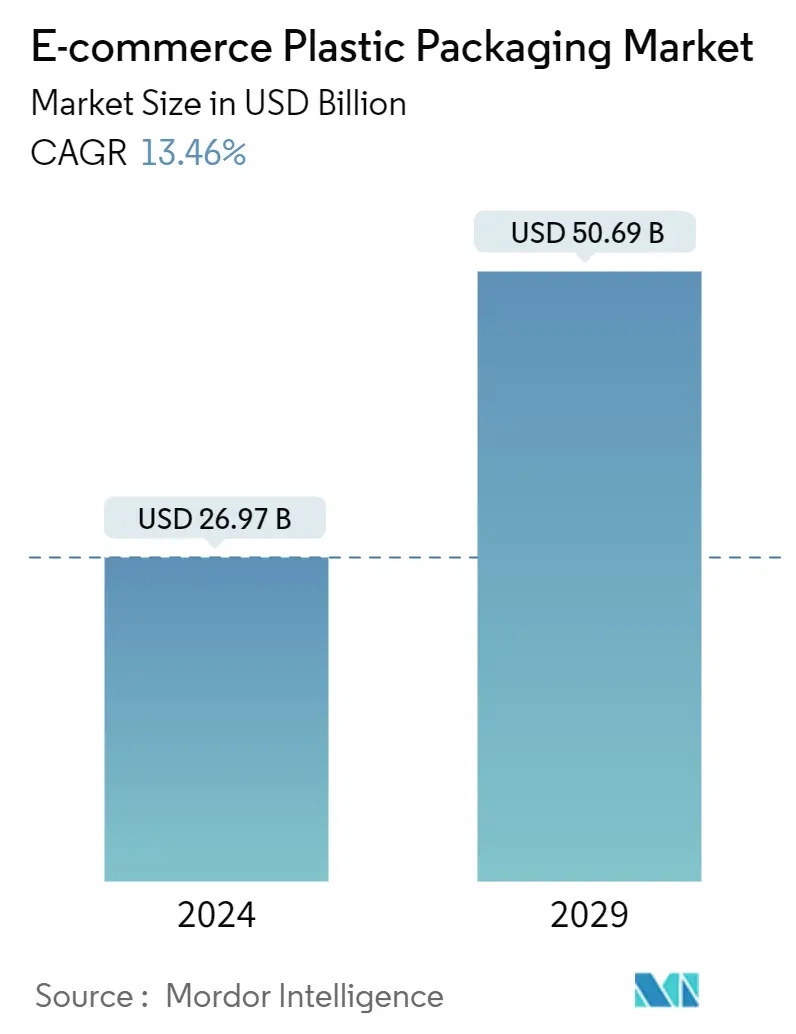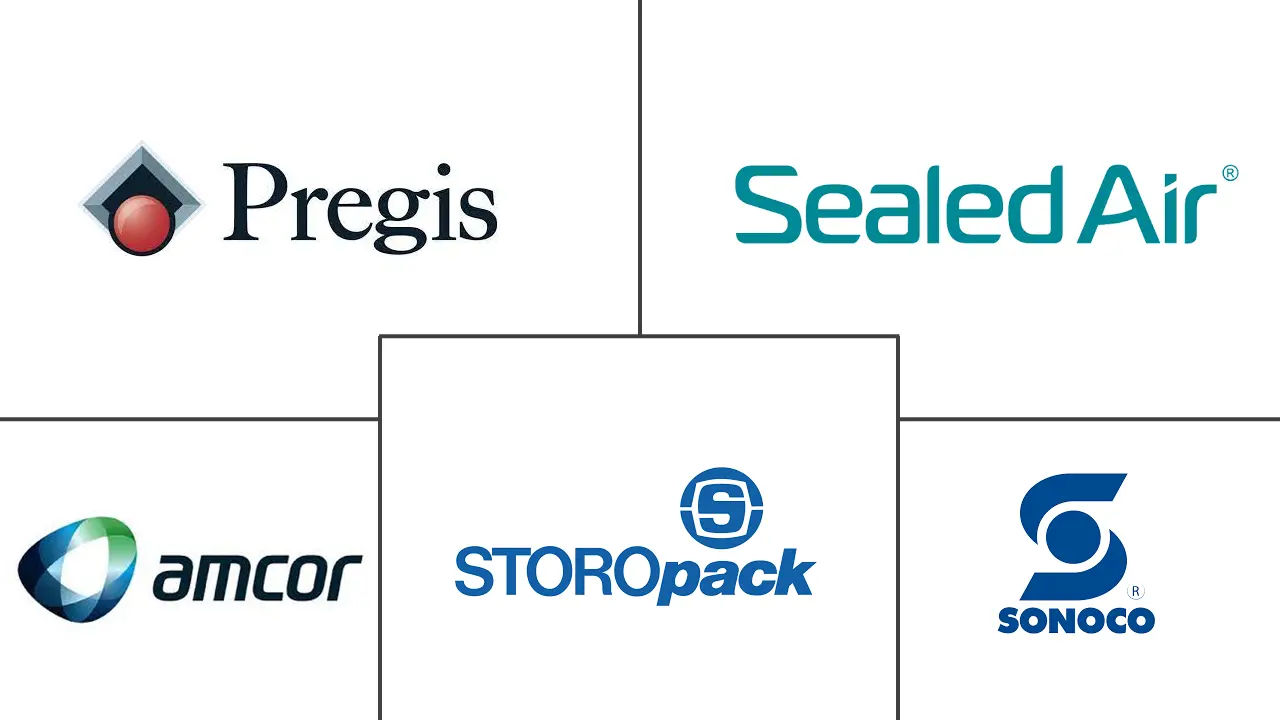Market Size of E-commerce Plastic Packaging Industry

| Study Period | 2019 - 2029 |
| Market Size (2024) | USD 26.97 Billion |
| Market Size (2029) | USD 50.69 Billion |
| CAGR (2024 - 2029) | 13.46 % |
| Fastest Growing Market | Asia Pacific |
| Largest Market | Asia Pacific |
| Market Concentration | Medium |
Major Players
*Disclaimer: Major Players sorted in no particular order |
E-commerce Plastic Packaging Market Analysis
The E-commerce Plastic Packaging Market size is estimated at USD 26.97 billion in 2024, and is expected to reach USD 50.69 billion by 2029, growing at a CAGR of 13.46% during the forecast period (2024-2029).
Packaging and labeling directly impact the sales and profits of a business. E-commerce packaging consists of various packaging solutions made from materials used for content protection, product density management, promotional tools, product identification, and user convenience during handling and logistics. Plastic has been one of the critical materials used in e-commerce packaging.
- Flexible packaging is an ideal format for e-commerce to withstand more touchpoints throughout the shipment process. Moreover, flexible packaging material can prevent spills, resist breakage, and hold products together. Compared to conventional retail, e-commerce products are handled at least three times, according to Plastics Today.
- Flexible packaging also drives shipping cost efficiencies as the billable weight for a package is usually determined by whichever value is the greater, actual, or dimensional weight. Therefore, more space-efficient formats like flexible plastic packaging drive lower shipping prices and are hence most prevalent in the e-commerce sector.
- Moreover, flexible plastic packaging has presented difficulties with recycling because it is generally comprised of various layers that require to be separated to become feasible. Many market players are now working to develop more simple materials that can be easily recycled. The players in the plastic packaging industry are developing mono-polymer flexible packaging laminates to ensure circularity while capitalizing on the many benefits of the flexible plastic packaging format.
- Plastic packaging can contain residues from substances used during the manufacturing process, such as solvents, along with non-intentionally added substances (NIAS), such as oligomers, impurities, or degradation products. There are increasing concerns over additives used to manufacture virgin plastics that complicate recycling or pose risks to human or ecological health.
- For manufacturers of recycled plastics, uncertainty about the presence of these additives in plastic waste can hinder recycling altogether. The lack of information and transparency regarding the use of additives in some plastic waste streams is thus a significant barrier to the increased recycling of those products and, in turn, to the market studied.
E-commerce Plastic Packaging Industry Segmentation
The plastic packaging used by e-commerce companies accounts for a significant part of the packaging material. For products which are light and not fragile, such as clothes, it is ideal.
The e-commerce plastic packaging market is segmented by product type (pouches & bags, protective packaging, shrink films, and other product types), end-user industry (consumer electronics & media, food & beverage, personal care products, fashion & apparel, home care & furnishing, and other end-user industries), and geography (North America (United States, Canada), Europe (United Kingdom, Germany, France, Spain, and Rest of Europe), Asia-Pacific (China, Japan, India, and Rest of Asia Pacific), Latin America (Brazil, Mexico, and Rest of Latin America), and the Middle East and Africa). The report offers market forecasts and size in volume (tons) and value (USD) for all the above segments.
| By Product Type | |
| Pouches and Bags | |
| Protective Packaging | |
| Shrink Films | |
| Other Product Types |
| By End-user Industry | |
| Consumer Electronics and Media | |
| Food and Beverage | |
| Personal Care Products | |
| Fashion and Apparel | |
| Home Care and Furnishing | |
| Other End-user Industries |
| By Geography*** | ||||||
| ||||||
| ||||||
| ||||||
| ||||||
| Middle East and Africa |
E-commerce Plastic Packaging Market Size Summary
The e-commerce plastic packaging market is poised for significant growth, driven by the increasing demand for efficient and sustainable packaging solutions in the rapidly expanding online retail sector. Plastic packaging plays a crucial role in e-commerce by providing protection, product density management, and user convenience during handling and logistics. Flexible plastic packaging, in particular, is favored for its ability to withstand multiple touchpoints during shipment, prevent spills, and reduce shipping costs due to its space-efficient nature. However, challenges remain in recycling these materials, as they often consist of multiple layers that complicate the recycling process. Industry players are actively working on developing mono-polymer flexible packaging laminates to enhance recyclability while maintaining the benefits of flexible packaging.
The market landscape is semi-consolidated, with key players like Storopack Hans Reichenecker GmbH, Berry Global Inc., Sealed Air Corporation, Pregis LLC, Sonoco Products Company, and Amcor Group GmbH leading the charge in innovation and sustainability. These companies are expanding their operations and forming strategic partnerships to enhance their market presence and develop environmentally friendly packaging solutions. The growing e-commerce markets in regions such as China, India, and Japan are contributing to the demand for plastic packaging, as consumers increasingly prefer online shopping and require reliable packaging solutions for safe product delivery. As the market continues to evolve, the focus on sustainability and circularity in plastic packaging is expected to drive further growth and innovation.
E-commerce Plastic Packaging Market Size - Table of Contents
-
1. MARKET INSIGHTS
-
1.1 Market Overview
-
1.2 Industry Attractiveness - Porter's Five Forces Analysis
-
1.2.1 Bargaining Power of Suppliers
-
1.2.2 Bargaining Power of Buyers/Consumers
-
1.2.3 Threat of New Entrants
-
1.2.4 Threat of Substitutes
-
1.2.5 Intensity of Competitive Rivalry
-
-
1.3 Industry Value Chain Analysis
-
-
2. MARKET SEGMENTATION
-
2.1 By Product Type
-
2.1.1 Pouches and Bags
-
2.1.2 Protective Packaging
-
2.1.3 Shrink Films
-
2.1.4 Other Product Types
-
-
2.2 By End-user Industry
-
2.2.1 Consumer Electronics and Media
-
2.2.2 Food and Beverage
-
2.2.3 Personal Care Products
-
2.2.4 Fashion and Apparel
-
2.2.5 Home Care and Furnishing
-
2.2.6 Other End-user Industries
-
-
2.3 By Geography***
-
2.3.1 North America
-
2.3.1.1 Canada
-
-
2.3.2 Europe
-
2.3.2.1 United Kingdom
-
2.3.2.2 Germany
-
2.3.2.3 France
-
2.3.2.4 Spain
-
-
2.3.3 Asia
-
2.3.3.1 China
-
2.3.3.2 India
-
2.3.3.3 Japan
-
2.3.3.4 Australia and New Zealand
-
-
2.3.4 Latin America
-
2.3.4.1 Brazil
-
2.3.4.2 Mexico
-
2.3.4.3 America
-
-
2.3.5 Middle East and Africa
-
-
E-commerce Plastic Packaging Market Size FAQs
How big is the E-commerce Plastic Packaging Market?
The E-commerce Plastic Packaging Market size is expected to reach USD 26.97 billion in 2024 and grow at a CAGR of 13.46% to reach USD 50.69 billion by 2029.
What is the current E-commerce Plastic Packaging Market size?
In 2024, the E-commerce Plastic Packaging Market size is expected to reach USD 26.97 billion.

